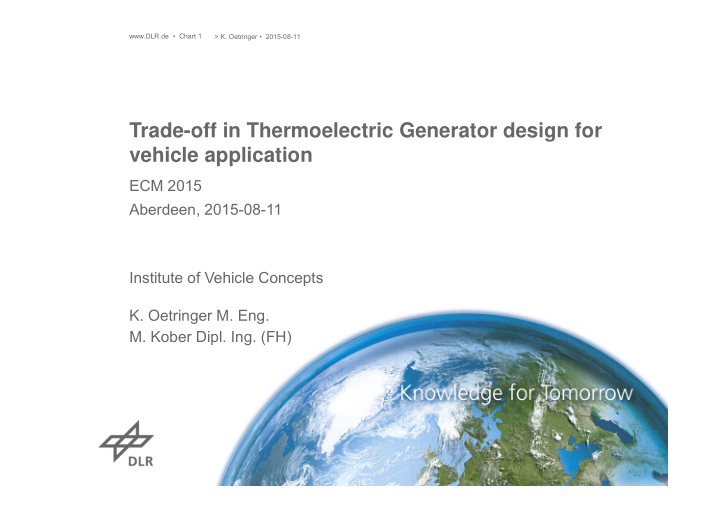



www.DLR.de • Chart 1 > K. Oetringer • 2015-08-11 > K. Oetringer • 2015-08-11 Trade-off in Thermoelectric Generator design for vehicle application ECM 2015 Aberdeen, 2015-08-11 Institute of Vehicle Concepts K. Oetringer M. Eng. M. Kober Dipl. Ing. (FH)
www.DLR.de • Chart 2 > K. Oetringer • 2015-08-11 Outline Introduction • Motivation • Basics • TEG Evolution at DLR • Optimization • Design-Point • Simulative Results • Validation by Measurement • Outlook •
www.DLR.de • Chart 3 > K. Oetringer • 2015-08-11 Motivation for waste heat recovery Basic combustion engine About 2/3 of the chemical energy is transferred to heat 1) Treffinger P., Häfele Ch., Weiler T. DLR e.V. Stuttgart; Eder A., Richter R., Mazar B. BMW Group München: Energierückgewinnung durch Wandlung von Abwärme in Nutzenergie. 2008 VDI Tagung „Innovative Fahrzeugantriebe“, Dresden
www.DLR.de • Chart 4 > K. Oetringer • 2015-08-11 Abgas Abgas Basics of thermoelectricity heiß heiß • thermal diffusion of electrons respectively holes to cold side n n p p - - + + - - • Electric potential is proportional to Δ T: + + U kalt kalt S Seebeck-coefficient S T Kühlmittel Kühlmittel • Dimensionless figure of merit ZT: 2 σ S electrical conductivity ZT T Κ thermal conductivity T temperature • Efficiency TE: P T T ZT 1 1 el h k T T Q k ZT 1 h in T h
www.DLR.de • Chart 5 > K. Oetringer • 2015-08-11 Abgas Abgas Basics of thermoelectricity in application heiß heiß n n p p - - + + - - + + • Electric potential is proportional to Δ T: U kalt kalt S Seebeck-coefficient S T Kühlmittel Kühlmittel • Dimensionless figure of merit ZT: 2 σ S electrical conductivity ZT T Κ thermal conductivity T temperature • Efficiency TE: P T T 1 el h k 4 T T Q T h k 2 in h ZT 2 T h h
www.DLR.de • Chart 6 > K. Oetringer • 2015-08-11
www.DLR.de • Chart 7 > K. Oetringer • 2015-08-11 Outline Introduction • Motivation • Basics • TEG Evolution at DLR • Optimization • Design-Point • Simulative Results • Validation by Measurement • Outlook •
www.DLR.de • Chart 8 > K. Oetringer • 2015-08-11 Optimize the benefit for the application electrical TEG input power cooling load ( ) P co ( ) (el. power for cooling water P in pump and cooling fan, quick heat-up phase) back pressure / cooling of exhaust rolling resistance ( ) P ro ( ) (weight increase) P pr
www.DLR.de • Chart 9 > K. Oetringer • 2015-08-11 Choosing a Design-Point Basic for Vehicle testing => WLTC
www.DLR.de • Chart 10 > K. Oetringer • 2015-08-11 Choosing a Design-Point Which Design-Point contains most energy? possible Design-Point 15 g/s 400°C
www.DLR.de • Chart 11 > K. Oetringer • 2015-08-11 Choosing a Design-Point Which Design-Point contains most energy? possible Design-Point 15 g/s 400°C
www.DLR.de • Chart 12 > K. Oetringer • 2015-08-11 Choosing a Design-Point Which Design-Point contains most energy? possible Design-Point 15 g/s � � � � � � ⋅ � � ⋅ �� � �� � � 400°C � : Energy contained by Design Point � � � : usable Massflow � � : heat capacity of exhaust � � : usable Temperature � � : coldside Temperature of TEG
www.DLR.de • Chart 13 > K. Oetringer • 2015-08-11 Choosing a Design-Point Which Design-Point contains most energy? Design-Point: 17g/s 855 K
www.DLR.de • Chart 14 > K. Oetringer • 2015-08-11 Simulative results Characteristics of the optimized TEG • weight < 8 kg (without bypass) • volume < 3 dm³ (without bypass and diffusers) • el. peak power > 400 W • el. power at Design-Point > 160 W • gravimetric power density > 50 W/kg • volumetric power density > 133 W/dm³
www.DLR.de • Chart 15 > K. Oetringer • 2015-08-11 Measured results Validation of simulation
www.DLR.de • Chart 16 > K. Oetringer • 2015-08-11 Measured results Validation of simulation 800,0 25,00 750,0 700,0 20,00 650,0 electric power TEM2 [W] temperature [K] 600,0 15,00 550,0 500,0 10,00 450,0 400,0 5,00 350,0 300,0 0,00 0 1 2 3 Design ‐ Point maximum Point Th_TEM2 [K] Tc_TEM2 [K] Th_sim [K] Tc_sim [K] P.el_TEM2 [W] P.el_sim [W]
www.DLR.de • Chart 17 > K. Oetringer • 2015-08-11 Outline Introduction • Motivation • Basics • TEG Evolution at DLR • Optimization • Design-Point • Simulative Results • Validation by Measurement • Outlook •
www.DLR.de • Chart 18 > K. Oetringer • 2015-08-11 Outlook / Summary Philosophy to success: • Maximizing the benefit for OEM and Driver => taking into account negative effects • Not maximizing the el. power output Reached goals: • Successful integration of high temperature modules • Validation of thermal simulation Outlook: • Dynamic simulation to simulate a whole driving cycle • Improve / research at high temperature modules
www.DLR.de • Chart 19 > K. Oetringer • 2015-08-11 The Project RExTEG Project aim: Developing a new kind of Thermoelectric Generator increasing the efficiency of Range Extender and Hybrid Vehicles • Potentials • Measuring vehicle • Materials • Concept development • Simulation • Functioning mock up • Validation Ministry of Finances and Economics Baden-Württemberg
www.DLR.de • Chart 20 > K. Oetringer • 2015-08-11 Thank you for your attention! Institute of Vehicle Concepts Pfaffenwaldring 38 ‐ 40 70569 Stuttgart Kerstin Oetringer M. Eng. Phone: 0049 ‐ 711 6862 ‐ 516 kerstin.oetringer@dlr.de www.DLR.de/fk
Recommend
More recommend